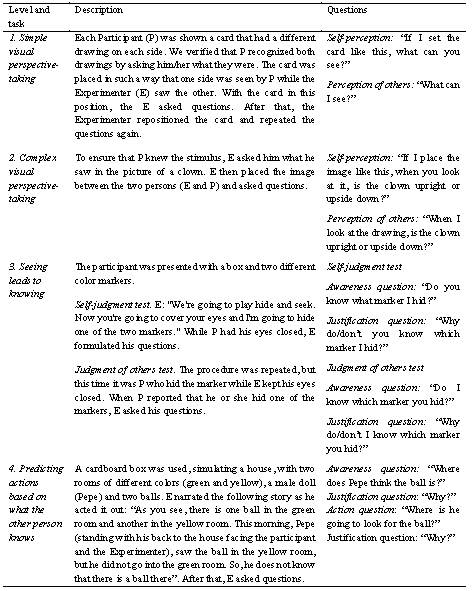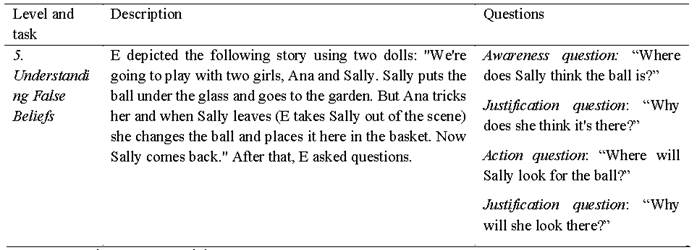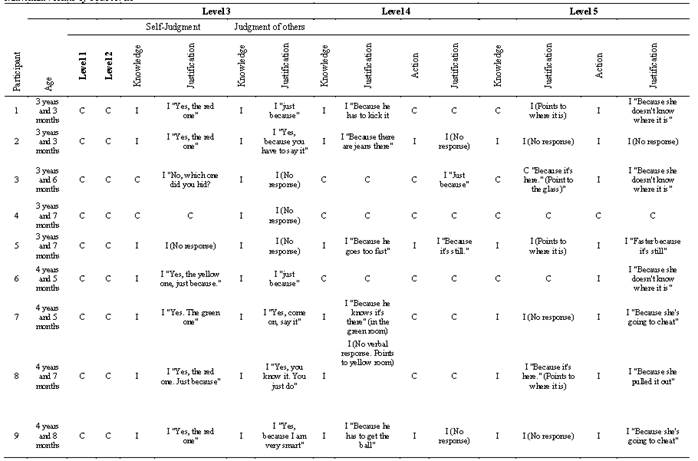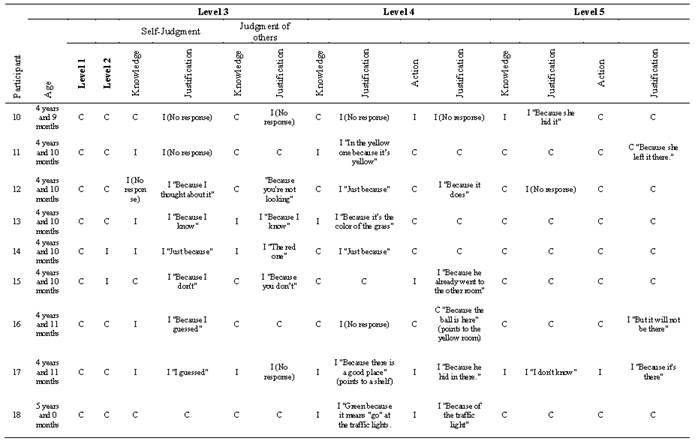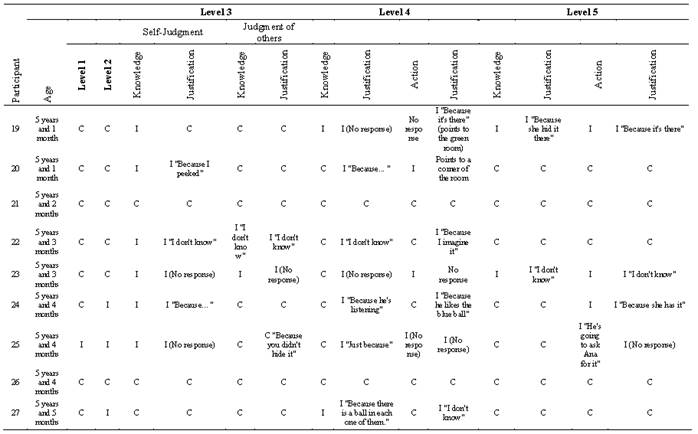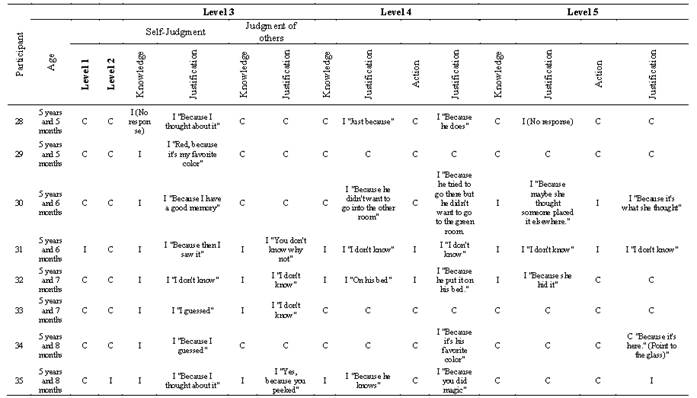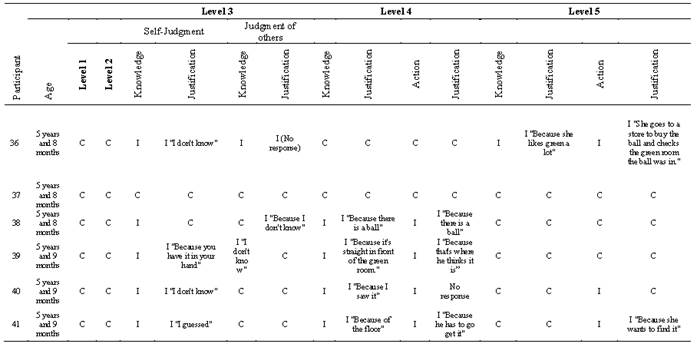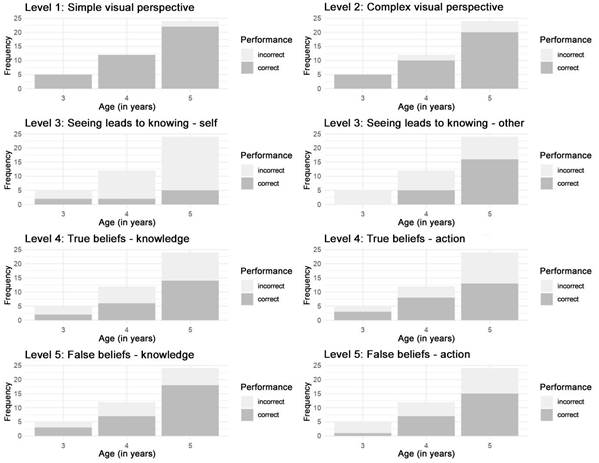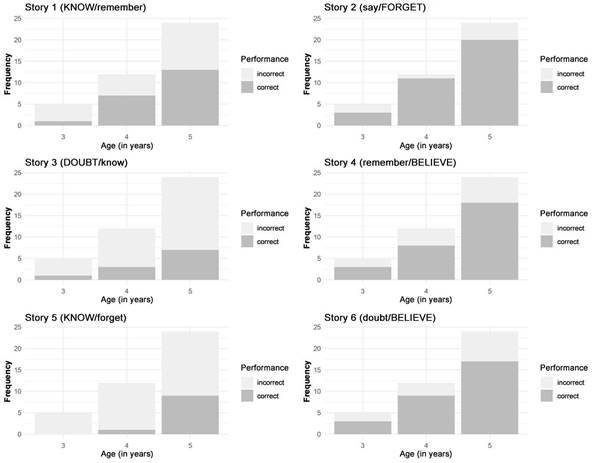Servicios Personalizados
Revista
Articulo
Links relacionados
Compartir
Ciencias Psicológicas
versión impresa ISSN 1688-4094versión On-line ISSN 1688-4221
Cienc. Psicol. vol.16 no.1 Montevideo 2022 Epub 01-Jun-2022
https://doi.org/10.22235/cp.v16i1.2444
Original Article
Theory of mind skills and understanding of mentalistic verbs in typically developing children
1 Universidad Católica del Uruguay, Uruguay
2 Universidad Católica del Uruguay, Uruguay
3 Universidad Católica del Uruguay, Uruguay, maria.montoya@ucu.edu.uy
4 Universidad Santo Tomás, Colombia
5 Universidad Santo Tomás, Colombia
6 Universidad Católica del Uruguay, Uruguay
7 Universidad Católica del Uruguay, Uruguay
8 Universidad Católica del Uruguay, Uruguay
The learning of theory of mind (ToM) skills is considered essential to guarantee good adaptive performance in the social context since it allows people to attribute mental states to themselves and others, and thus be able to predict the behavior of others. The aim of the present study was to analyze the performance of ToM tasks and the understanding of mental verbs contextualized in stories with typically developing children. A sample of 41 children aged between 3 and 5 years was used with a descriptive methodology. Results show that ToM level 3 was the one with the lowest levels of achievement. In relation to the test that evaluated the understanding of mental verbs, the lowest results were obtained in the one that referred to the verb to know. Results found suggest that mental verbs referring to desires first learned before beliefs, as well as that the levels of information defended by the ToM model of Howlin et al. (1999) are not sequenced in levels of complexity.
Keywords: theory of mind; mental verbs; typical development; early childhood
El aprendizaje de habilidades de la teoría de la mente (ToM) se considera fundamental para garantizar un buen desempeño adaptativo en el contexto social dado que permite a las personas atribuir estados mentales a sí mismas y a otras, y así poder predecir el comportamiento de los demás. El objetivo del presente estudio consistió en analizar el desempeño en las tareas de ToM y en la comprensión de verbos mentalistas contextualizados en historias en niños con desarrollo normativo. Se utilizó una muestra de 41 niños con edades comprendidas entre 3 y 5 años con una metodología descriptiva. Los resultados muestran que el nivel 3 de ToM fue el que obtuvo menores niveles de logro. En relación con la prueba que evaluaba la comprensión de verbos mentalistas, los resultados más bajos se obtuvieron en aquella que hacía referencia al verbo saber. Los resultados encontrados sugieren que se aprenden primero verbos mentales referidos a deseos antes que a creencias, así como que los niveles de información defendidos por el modelo de ToM de Howlin et al. (1999) no parecerían estar secuenciados en niveles de complejidad.
Palabras clave: teoría de la mente; verbos mentalistas; desarrollo típico; primera infancia
A aprendizagem das habilidades de teoria da mente (ToM) é considerada fundamental para garantir um bom desempenho adaptativo no contexto social, pois permite às pessoas atribuir estados mentais a si mesmas e aos outros, e assim prever o comportamento das pessoas. O objetivo do presente estudo foi analisar o desempenho nas tarefas de ToM e na compreensão de verbos metacognitivos contextualizados em histórias em crianças com desenvolvimento normativo. Uma amostra de 41 crianças de 3 a 5 anos foi utilizada com uma metodologia descritiva. Os resultados mostram que o nível 3 de ToM foi o que teve os menores níveis de acertos. Em relação ao teste que avaliou a compreensão dos verbos metacognitivos, os resultados mais baixos foram obtidos no teste que se referia ao verbo saber. Os resultados encontrados sugerem que os verbos mentais referentes aos desejos são aprendidos primeiro antes das crenças, e que os níveis de informação defendidos pelo modelo ToM de Howlin et al. (1999) não parecem estar em sequência de níveis de complexidade.
Palavras-chave: teoria da mente; verbos metacognitivos; desenvolvimento típico; primeira infância
The theory of mind (ToM) involves the complex human ability to understand and predict the behavior of others (Tirapú-Ustárroz et al., 2007). This ability allows the individual to attribute mental states (emotions, thoughts, beliefs, desires, and intentions) to another person and thus be able to predict their behavior, helping them to adapt to the environment. The skills involved in ToM allow for adaptive performance at a social level since understanding what another individual thinks or feels, as well as understanding lying, deception or persuasion, makes it possible to regulate interactions with others (Barreto et al., 2018; Bartsch & London, 2000; Camacho, 2005; Ding et al., 2015).
Howlin et al. (1999) outlined a ToM model with five levels of knowledge with the aim of ordering the tasks according to their complexity and developing an assessment and training protocol that would follow the natural order that occurs during the evolutionary development of a child. The first level, called simple visual perspective-taking, refers to the fact that different people can observe different things. The second level, complex visual perspective-taking, implies that two subjects may be observing the same object and still have a different point of view since each person observes it from his or her own place. The third level refers to the principle "seeing leads to knowing", which denotes the fact that individuals only know what they have had a direct or indirect experience with; while the fourth level, true beliefs, consists, of being able to understand that other individuals may have beliefs that are the result of their previous experience, and thus make predictions based on the beliefs they have. Finally, the fifth level, false beliefs, involves predicting what another person is going to do, knowing that the knowledge that person has about reality is false, which requires the recognition that other individuals may have beliefs that differ from their own and from reality itself (Ziv et al., 2015).
Regarding empirical evidence on the progression of these skills, some authors have found that at the age of 3 years typically developing children have already acquired the first level of simple visual perspective (Gjerde et al., 1986; Poulin-Dubois et al., 2007), but not the second level, which would not be reached until the age of 4 (Bigelow & Dugas, 2008; Flavell, 1978; Masangkay et al., 1974). As for the third and fourth levels, there seems to be some agreement that they tend to emerge between the ages of 3 and 4 (Baron-Cohen, 2001; Pratt & Bryan, 1990; Wellman & Liu, 2004). On the other hand, some studies suggest that the fifth level develops between the ages of 4 and 6 (Astington & Gopnick, 1991; Wellman et al., 2001; Wimmer & Perner, 1983), although some authors have identified it before the age of 4 (He et al., 2011; Onishi & Baillargeon, 2005). Moreover, success in tasks involving false second-order beliefs is reported later, between 6 and 7 years of age (Jingxin et al., 2006; Perner & Wimmer, 1985). Wellman and Liu (2004) tested an evolutionary sequence of mental state understandings suggesting that the understanding of diverse desires precedes the understanding of diverse beliefs, and that diverse belief understanding precedes knowledge judgments, while false belief understanding is further along in the sequence.
The empirical study on the ontogenetic development of ToM in humans has also revealed that its evolution occurs concurrently with other socio-cognitive skills such as social problem solving, the understanding of emotions and social situations, among others (Longobardi et al., 2016); particularly, it has been reported that the linguistic skills of typically and atypically developing children co-vary with the development of ToM, specifically, with the execution of false belief tasks (Dunn & Brophy, 2005; Meins et al., 2002; Milligan et al., 2007; Pyers & Senghas, 2009; Shatz et al., 1983; Tager-Flusberg & Joseph, 2005).
These language skills include, among others, the production and understanding of terms that refer to behavior that is not directly observable, generically referred to as Mental State Language (MSL) or psychological lexicon, which may be emotional (i.e., be happy, in love, hateful), volitional (i.e., trying, deciding, be capable), cognitive (i.e., to understand, believe, remember) or moral (i.e., being bad, sorry, forgiving) (Baron-Cohen, 2001; Bermúdez-Jaimes & Escobar-Melo, 2014; Howard, 2012; Longobardi et al., 2015; Resches et al., 2010; Rollo & Sulla, 2016).
For Antonietti et al. (2006), MSL is considered as meta-representational expressions, if in order to understand them (as well as to use them correctly) individuals must enact the representational attitude implied by such verbs (e.g., to remember, to expect, to hope, to wish, etc.) and the content of the representational state (e.g., whatever is remembered, expected, or wished for). In turn, Nelson (2005) proposes that it is through language that children engage in social practices, conversational exchanges, make-believe play, and other interactions that foster their ability to link overt behaviors with mental states that are inaccessible to the child's direct observation. Along the same lines, Olson et al. (2006) assert that language fulfills a mediating function through syntactic, semantic, and pragmatic mechanisms developed through different experiences that allow the child to separate the propositional content of an utterance (i.e., that which is said) from its illocutionary force, which depends on the state of mind of the speaker. In other words, to discover the tacit inferences implied in conversation, the child must learn to identify the mental states that underlie words, which is why it is crucial to understand how the use of mental terms is learned.
Although it has been widely reported that language skills play a key role in the development of ToM, it is not yet clear which dimension can explain this relationship. To address this issue, performance in first- and second-order false belief tasks (Perner & Wimmer, 1985) has traditionally been assumed as the operational definition of ToM, in which the individual must make inferences about an agent's behavior based on erroneous beliefs that this agent may have (Longobardi et al., 2015). On the other hand, the use and understanding of MSL has been operationalized through direct observation in naturalistic conversations, standardized tests, or performance in linguistic skills tasks (Milligan et al., 2007). Based on this, it has been demonstrated through correlational studies (e.g., de Villiers & de Villiers, 2000; Hughes & Dunn, 1998; Schick et al., 2007), and exposure to different types of training (e.g., Hale & Tager-Flusberg, 2003; Lohmann & Tomasello, 2003; Ornaghi et al., 2011), that MSL development can predict false belief tasks performance; however, the central problem lies in identifying the role played by different linguistic dimensions, such as syntactic complexity, semantic development, receptive vocabulary, or general or specific grammatical constructions, on false belief understanding (Farrar et al. , 2009).
Regarding the development of semantic-lexical skills, it has been shown that the availability of terms to describe one's own and others' mental states is a necessary condition for the development of initial ToM skills, the child's metarepresentational ability, and for overcoming first and second order false belief tasks. (Bartsch & Wellman, 1995). It has been found that, between the ages of 2 and 4 years, children initially use MSL as a conversational device, and later as means to refer to mental states (Astington & Peskin, 2004; Grazzani & Ornaghi, 2012; Shatz et al., 1983); similarly, evidence shows that children first use MSL to refer to themselves (e.g., I want, I don't like, etc.) and later to refer to mental states of others (e.g., you want, you like, etc.) (Hughes & Dunn, 1998). For example, Wellman and Johnson (1979) evaluated the understanding of the terms remember and forget in children aged 3, 4, 5 and 7 years, finding that the first distinct understanding occurred around the age of 4, and that there is a progression in this understanding from overt behavioral characteristics to an understanding in terms of the agent’s internal states (Saracho, 2014).
Around 2 years of age, typically developing children begin to make natural and everyday use of LEM about mental states related to volitions, (e.g., desires and preferences), perceptions (e.g., seeing, feeling) and positive and negative emotions, first basic, and then complex and social; by age 3 they begin to use a more complex LEM related to cognitions, thoughts and beliefs (Farrar et al., 2009; Ornaghi et al., 2011). With children aged 8-10 years old, Grazzani and Ornaghi (2012) found that the use and understanding of MSL and metacognitive language successfully predicted performance on false-belief and emotion comprehension tasks.
In particular, mental terms related to desire and belief are similar as they imply intentional states; however, their appearance do not occur simultaneously in children's vocabulary. (Pascual et al., 2008). By their second year of life, children begin to use terms that express desire (e.g., I want). These verbs precede terms concerning belief, which involve talking about beliefs and thoughts, such as “I know”, “I think”, or “I forget”, which appear in the vocabulary around the middle of the third year (Bartsch & Wellman, 1995; Ferres, 2003; Moore et al., 1994). The propositional attitude characteristic of both types of mental terms indicates how a person relates to the world and portrays it; however, children do not initially employ the terms in this sense, i.e., they do not use them to make genuine reference to a mental state but tend to use them in a mechanical and stereotyped way, purely for conversational purposes (Pascual et al., 2008).
In terms of syntactic complexity, various authors (de Villiers & de Villiers, 2000; Peters et al., 2009; Schick et al., 2007) have posited that advanced syntax, specifically in relation to the understanding and use of syntactic complements, is a prerequisite for ToM development, since children need to think about mental states and the only way to do so is in terms of linguistic complements that allow them to represent the mental state of others; e.g., by saying she thinks the ball is in the basket. In other words, these syntactic complements allow the child to represent the world through the eyes of other people and compare his or her own world with those representations. (Peters et al. 2009).
On the other hand, it has been proposed that children's exposure and participation in conversational scenarios about mental states is a key factor for the understanding of their own and others' mental processes, since speaking in MSL terms promotes the coordination of different points of view about the same event, promotes reflection, and stimulates the comparison between their own and others' mental states (Carpendale & Lewis, 2004; de Rosnay & Hughes, 2006; Nelson, 2005). In fact, Nelson (2005) offers a theoretical proposal in which conversations about mental states constitute the learning context in which ToM skills are developed, as they allow the child to interact within a community of minds that fosters reflection on one's own and others' mental states through shared social experiences.
In this regard, it has been reported that training in the use of complex syntactic constructions in conversations, direct feedback, and additional explanations about mental states, foster better performance in false belief tasks (Hale & Tager-Flusberg, 2003; Lohmann & Tomasello, 2003; Ornaghi et al., 2011). For example, Lecce et al. (2014) and Bianco et al. (2015) reported that the application of conversational scenario training programs based on the use of MSL with 9- and 10-year-old children, generated positive effects on ToM performance tasks; particularly, Bianco et al. (2015) found a beneficial effect of training in the accuracy of attributions about mental states on ToM development. Both studies show that conversational experience involving MSL may improve reasoning about mental states and the understanding of social situations in middle school children.
Thus, MSL is progressively acquired, since it begins as a means for the child to express his or her own needs through signaling, and later proceeds to intentional communication. (Bartsch & Wellman, 1995; Bermúdez-Jaimes & Escobar, 2014; Ferres, 2003). This type of communication implies that children begin to recognize that the others have thoughts, emotions, and beliefs, which allow them to get what they want. According to Resches et al. (2010), intentional communication, and the development of socio-cognitive skills, become a primary factor in the learning of verbs. Consequently, the progressive acquisition of oral language and the use of mentalistic terms are considered to have an impact on ToM development (Bermúdez-Jaimes & Escobar, 2014).
The study presented here was aimed at analyzing, on one hand, the performance in the five levels proposed by the ToM in a sample of children with normative development and, on the other hand, the comprehension of mentalistic verbs that were presented in the context of stories. This would allow us to determine whether there is a link between knowledge of this type of verb and performance in ToM tasks. According to the reviewed literature, it is hypothesized that the knowledge and comprehension of mentalistic verbs is related to ToM task development.
Materials and Methods
Participants
The participants were 41 typically developing children aged 3 years, 3 months to 5 years, 9 months (n = 5 for 3 years, n = 12 for 4 years and n = 24 for 5 years old), randomly selected by convenience sampling. All participants were attending a private school in Montevideo with a medium-high socioeconomic level. An informed consent form was obtained from the parents prior to their participation, detailing the institutional framework, the research objectives, the voluntary nature of their participation, the opportunity to discontinue the study when they considered it appropriate, anonymity and confidentiality in the handling of the data collected. Inclusion criteria required: (a) absence of developmental alterations and learning difficulties as reported by parents and teachers, (b) following instructions, and (c) absence of disruptive behaviors that could hinder the task.
Ethical considerations
This study is part of the Functional Approach to perspective-taking in typical development and developmental disorders research line, whose project was approved by the Ethics Committee of the Catholic University of Uruguay and complied with Decree 158/19 of the Executive Branch of Government, which regulates research involving human subjects in Uruguay under legal procedures for the protection of the participants' identity.
Tools
Theory of mind
To evaluate the five ToM levels, we used the procedure described in Howlin et al. (1999), translated by Montoya-Rodríguez and Molina Cobos (2016). The following materials were necessary to carry out the tasks: a cardboard box (half painted green, half yellow), two different color markers, three dolls, two cards with different drawings on both sides (i.e., car/cow, grandma/heart), a card with a clown, two small balls, an opaque glass and a basket. The tasks were performed as detailed in Table 1 12 .
Mentalistic verbs
On the other hand, mentalistic verbs were assessed by adapting the test proposed by Antonietti, Liverta-Sempio and Marchetti (2006), which was based on the presentation of a series of stories as specified in Table 2. Adaptations were made by the first and third authors, and involved reducing the number of stories, reducing the number of response options in each story, as well as modifying the application method from written to oral.
Table 2: Details of mentalistic verb understanding assessment tasks, adapted from Antonietti et al. (2006)
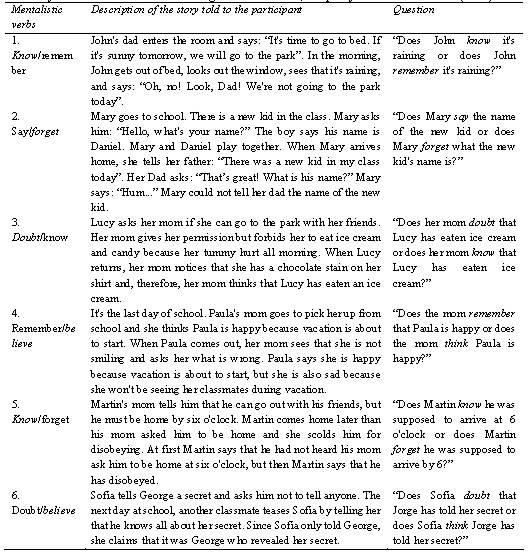
Note: The verb in italics of the pairs in the first column indicates the correct verb.
Procedure
The research was conducted during school hours at the children's educational institution. Specifically, in a 5 x 3 meter (160 sq. ft.) room with different amenities, such as two chairs, a table, a photocopier, a board, and a library. For each of the tests, the Experimenter was provided with a record sheet detailing the sequence of each task, as well as the correct answers to each question.
The study lasted for two weeks during which each participant completed two individual sessions. In the first 15-minute session, we evaluated the five ToM levels, while in the second 10-minute session we evaluated the mentalistic verbs. Before starting, participants were informed that they could ask for a break or could return to class at any time, although none of them requested it. Since this was an assessment, there were no corrections or positive feedback presented to the participants' correct answers at any time. Nor were any aids provided to facilitate the correction of the answers. Once the evaluation was completed, the participant returned to his or her classroom and the experimenter repeated the procedure with another participant.
Results
Theory of mind performance
The individual results may be consulted in Table 3 15 16 17 18, while the distribution of the performances, considering the participants' age per task, has been plotted in Figure 1 (it should be clarified that to consider the correct answers in this figure, answers to justifications were not considered). As shown, level 3 "seeing leads to knowing" in the “self” condition obtained the worst results across the different age groups. Only three participants (P21, P26 and P37) managed to solve all the questions of all the levels correctly, and these participants belonged to the 5-year age group. In terms of the age of the participants, 52.50 % of the 3-year-old participants managed to solve the different tasks, while for the 4-year-old this percentage was 59.38 % and 65.06 % for the 5-year-old.
Performance on understanding of mentalistic verbs
Table 4 shows the test data to evaluate the understanding of mentalistic verbs. The results show that story 5 (know/forget) was the worst performer with only 10 correct answers. In contrast, story 2 (say/forget) obtained the best results with 34 participants who managed to answer correctly.
Table 4: Evaluation results for mentalistic verb understanding
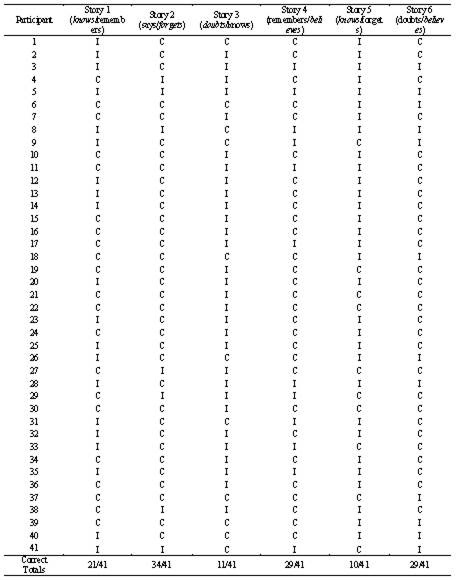
Note: I: incorrect answer; C: correct answer. The correct verb is indicated in italics.
Considering the age of the participants, Figure 2 shows that story 5 (know/forget) obtained the worst results among participants aged 3 and 4 years, while for 5-year-old participants it was story 3, although story 5 was the second story with the highest number of incorrect answers.
Discussion
In view of the results obtained in the sample, it seems that the levels of information advocated by the ToM model of Howlin et al. (1999) are not sequenced in levels of complexity. While level 3 obtained two correct answers from 3-year-old participants, seven correct answers from 4-year-old participants, and 21 correct answers from 5-year-old participants, level 4 obtained 5, 14, and 27 correct answers from 3-, 4-, and 5-year-old participants, respectively. In other words, more participants solved level 4 than level 3, regardless of age. Also, a larger portion of 5-year-old participants managed to solve level 4 earlier than level 5 (27 vs. 33 participants). This data would be in line with the findings from Montoya-Rodríguez and Molina Cobos (2016), who appeal to the suitability of attending to the child's learning history, and the contingencies at work during task completion to explain performance at different levels, as opposed to classical theories advocating a universal sequencing in stages of cognitive development such as those offered by Piaget (1972) or Yeates and Selman (1989).
Likewise, the participants' difficulty in justifying their responses with respect to the ToM levels is also noteworthy (see Table 3 15 16 17 18 ). An example of this would be the elaboration of causal explanations, where the most frequent answers were “just because” or the outright failure to provide any answer at all. These results could be attributed to the fact that participants either employ the expression for communication purposes, or they are in the transition from using mental verbs for conversational purposes to making genuine mental attributions. The response “just because” could indicate a sort of precursor to the use of mental verbs related to desires, with a similar function to expressions such as “because I feel like it”, which in turn resembles “want”, typical of this stage of development (Pascual et al., 2008). It is also interesting to note that in the sequence proposed by Wellman and Liu (2004), the understanding of desires as a mental state is the first point in their suggested progression of ToM tasks, prior to knowledge and belief judgments.
The difficulties observed in participants to justify their responses could also suggest an insufficient development of syntactic complementation structures (de Villiers, 2007; Pascual et al., 2008). Subordinate sentences with complements have been shown to be associated with the use frequency of desire and belief verbs referring to genuine mental states (Pascual et al., 2008). Verbs of this type are often the main verb in complex phrases that have subordinate sentences (called Complements) as their grammatical object (Astington & Baird, 2005). Additionally, mental verbs allow false sentences to be embedded in true sentences, thus it is claimed that syntactic structure provides the necessary format for representing beliefs as false. In other words, as long as syntax, barely developing by the age of four, does not allow for the representation of false complements, the child will not be able to generate symbolic representations sufficiently elaborated to overcome interpretations derived from direct experience (de Villiers, 2007; Remmel & Peters, 2009), This seems to be reflected in the justifications proposed by the participants of the present study.
Another characteristic that emerges from the data collected in Table 3 15 16 17 18 is the difference in results between the two questions for levels 4 and 5. While for the 3- and 4-year-olds it was easier to answer correctly to “Where the character ‘thinks’ the object is” than to “Where he will ‘look for’ it”, the opposite occurred in the 5-year-old group. A possible explanation for what happens with the younger participants could be that the verb think is more difficult to understand than the verb look for, perhaps because they are more familiar in their daily lives with searching, which is an observable action, and not so much with thinking, which requires inference and attribution of mental states. Although the differences between the results of the two questions are not very striking, these findings show that the logical relationship between knowing and acting in relation to what is known is not established at the studied ages. Another example regarding the difficulty involved in the attribution of mental states is presented in the results of the mentalistic verb stories (see Table 4), where the result of story 2 had the highest number of correct answers (34 out of 41). This is the only story that involves the verb to say, which is not a mental term since to say or not to say involves observable vocalization behavior. In other words, in this story a participant can easily respond by ruling out a factual action (i.e., to say or not to say) and does not require attributing mental states. Future studies could consider rephrasing the question in this story with a mentalistic verb.
On the other hand, the results show that mental verbs referring to desires are learned first before beliefs, an aspect aligned with the sequencing of mental state understanding of Wellman and Liu (2004) and Wellman et al. (2006).
From these results, a possible relationship between knowledge of mentalistic verbs and performance on ToM tasks emerges. Note that ToM level 3, the one with the worst results, refers to the verb to know, and it is on this verb that they had to respond in story 5 of the mentalistic verb task. A further example of this relationship could be found in the performance of participant 5, who responds incorrectly to most of the ToM levels, as well as to the stories of the mentalistic verbs test. It becomes necessary, however, to broaden the testing scenarios to analyze the strength of this relationship. Consistent with the latter, it is worth noting that the three stories containing the verb to know provided different performances in each of them. Among the possible explanations that account for these differences in performance could be the contents of the different stories or the specific verb pairing. To resolve this last issue, it should be analyzed whether solving stories that involve contrasting the know/remember or doubt/know pairs would be more accessible than contrasting know/forget.
Generally, these findings could be interpreted considering previous reports, according to which representational competence in the use of mental verbs develops at a later age than those involved in this sample. In fact, in the study by Olson et al. (2006), with participants from 8 to 14 years of age, the most difficult verbs to master were to assume, doubt and conclude, followed by to hypothesize, infer and remember, which is consistent with the incorrect executions of the much younger participants in the present study, in verbs such as to doubt, know, and believe, having similar characteristics of referential opacity between them (Pascual et al., 2008). This would lead us to wonder about the potential limitations of tools such as those used in this study for the evaluation of ToM in young children, since the ability to put themselves in the other's place and respond based on what they or someone else knows (as assessed in ToM level 3), will depend on the child's use and understanding of MSL, among other things.
Limitations and future studies
The scope of this study is mainly descriptive. Its conclusions could be extended in future studies that contemplate a wider age range, for greater performance variability, as well as a larger sample number that would allow conducting robust statistical analyses of task sequencing and difficulty. Future studies could also incorporate other variables to model the relationship between ToM skills and mentalistic verb understanding (e.g., general linguistic ability). On the other hand, it should not be ruled out that other factors inherent to the design of the tasks (e.g., features of the characters and materials, formulation of the questions, etc.) could explain performance differences, as well as the failure to counterbalance the presentation sequence of either tool could have introduced an order bias.
Although these findings need to be confirmed with larger samples, the analysis presented in this study could facilitate the adaptation of protocols for the design of interventions aimed at developing ToM skills involving the understanding of mentalistic verbs in children or groups with deficits, such as individuals with autism or developmental delay, as well as their strengthening within a typically developing population in non-clinical contexts.
REFERENCES
Antonietti, A., Liverta-Sempio, O., & Marchetti, A. (2006). Theory of mind and language in developmental contexts. Springer Science & Business Media. https://doi.org/10.1007/b106493 [ Links ]
Astington, J. & Baird, J. (2005). Introduction: Why language matters. En J. Astington & J. Baird (Eds.), Why language matters for Theory of Mind (pp. 3-25). Oxford University Press. https://doi.org/10.1093/acprof:oso/9780195159912.001.0001 [ Links ]
Astington, J. & Gopnik, A. (1991). Theoretical explanations of children's understanding of the mind. British Journal of Developmental Psychology, 9(1), 7-31. https://doi.org/10.1111/j.2044-835X.1991.tb00859.x [ Links ]
Astington, J. & Peskin, J. (2004). Meaning and use: Children's acquisition of the mental lexicon. En J. Lucariello, J. Hudson, R. Fivush, & P. Bauer (Eds.), The development of the mediated mind: Sociocultural context and cognitive development (pp. 59-78). Erlbaum. [ Links ]
Baron-Cohen, S. (2001). Theory of Mind in normal development and autism. Prisme, 34, 174-183. [ Links ]
Barreto, A., Osório, A., Baptista, J., Fearon, P., & Martins, C. (2018). Association between theory of mind and mental state talk in preschoolers and later social competence and behavior. Infant and Child Development, 27, 1-16. https://doi.org/10.1002/icd.2060 [ Links ]
Bartsch, K. & London, K. (2000). Children’s use of mental state information in selecting persuasive arguments. Developmental Psychology, 36(3), 352-365. https://doi.org/10.1037/0012-1649.36.3.352 [ Links ]
Bartsch, K. & Wellman, H. (1995). Children talk about the mind. Oxford University Press. [ Links ]
Bermúdez-Jaimes, M., & Escobar, H. (2014). Comprensión social y lenguaje: ¿dos dominios? Universitas Psyhologica, 13(1). https://doi.org/10.11144/Javeriana.UPSY131.csld [ Links ]
Bianco, F., Lecce, S., & Banerjee, R. (2015). Conversations about mental states and theory of mind development during middle childhood: A training study. Journal of Experimental Child Psychology, 149, 41-61. https://doi.org/10.1016/j.jecp.2015.11.006 [ Links ]
Bigelow, A. E. & Dugas, K. (2008). Relations among preschool children’s understanding of visual perspective taking, false belief, and lying. Journal of Cognition and Development, 9(4), 411-433. https://doi.org/10.1080/15248370802678299 [ Links ]
Camacho, V. (2005). Mentiras, relevancia y teoría de la mente. Pragmalingüística, 13, 51-64. https://doi.org/10.25267/Pragmalinguistica.2005.i13.03 [ Links ]
Carpendale, J. & Lewis, C. (2004). Constructing an understanding of mind: The development of children’s social understanding within social interaction. Behavioral and Brain Sciences, 27, 79-151. http://dx.doi.org/10.1017/S0140525X04000032 [ Links ]
de Rosnay, M., & Hughes, C. (2006). Conversation and theory of mind: Do children talk their way to socio-cognitive understanding? British Journal of Developmental Psychology , 24, 7-37. http://dx.doi.org/10.1348/026151005X82901 [ Links ]
de Villiers, J. G. & de Villiers, P. (2000). Linguistic determinism and the understanding of false beliefs. En P. Mitchell & K. Riggs (Eds.), Children’s reasoning and the mind (pp. 191-228). Psychology Press. [ Links ]
de Villiers, J. (2007). The interface of language and theory of mind. Lingua, 117, 1858-1878. https://doi.org/10.1016/j.lingua.2006.11.006 [ Links ]
Ding, X., Wellman, H., Wang, Y., Fu, G. & Lee, K. (2015). Theory-of-Mind training causes honest young children to lie. Psychological Science, 26(11), 1812-1821. https://doi.org/10.1177/0956797615604628 [ Links ]
Dunn, J. & Brophy, M. (2005). Communications, relationships and individual differences in understanding of mind. En J. Astington & J. Baird (Eds.), Why language matters for Theory of Mind (pp. 50-69). Oxford University Press. https://doi.org/10.1093/acprof:oso/9780195159912.001.0001 [ Links ]
Farrar, M., Johnson, B., Tompkins, V., Easters, M., Zilisi-Medus, A., & Benigno, J. (2009). Language and theory of mind in preschool children with specific language impairment. Journal of Communication Disorders, 42, 428-441. https://doi.org/10.1016/j.jcomdis.2009.07.001 [ Links ]
Ferres, L. (2003). Children’s early theory of mind: exploring the development of the concept of desire in monolingual Spanish children. Developmental Science, 6, 159-165. https://doi.org/10.1111/1467-7687.00266 [ Links ]
Flavell, J. H. (1978). The development of knowledge about visual perception. En C. B. Keasey (Ed.), The Nebraska symposium on motivation: Vol. 25. Social cognitive development (pp. 43-76). University of Nebraska Press. [ Links ]
Gjerde, P. F., Block, J., & Block, J. H. (1986). Egocentrism and ego resiliency: Personality characteristics associated with perspective-taking from early childhood to adolescence. Journal of Personality and Social Psychology, 51(2), 423-434. https://doi.org/10.1037/0022-3514.51.2.423 [ Links ]
Grazzani, I. & Ornaghi, V. (2012). How do use and comprehension of mental-state language relate to theory of mind in middle childhood? Cognitive Development, 27, 99-111. https://doi.org/10.1016/j.cogdev.2012.03.002 [ Links ]
Hale, C. & Tager-Flusberg, H. (2003). The influence of language on theory of mind: A training study. Developmental Science, 6, 346-359. http://dx.doi.org/10.1111/1467-7687.00289 [ Links ]
He, Z., Bolz, M., & Baillargeon, R. (2011). False‐belief understanding in 2.5‐year‐olds: evidence from violation‐of‐expectation change‐of‐location and unexpected‐contents tasks. Developmental science, 14(2), 292-305. https://doi.org/10.1111/j.1467-7687.2010.00980.x [ Links ]
Howard, A. (2012). Mental verb input for promoting children's theory of mind: A training study. Cognitive Development, 27(1), 64-76. https://doi.org/10.1016/j.cogdev.2011.10.003 [ Links ]
Howlin, P., Baron-Cohen, S., & Hadwin, J. (1999). Teaching children with autism to mind- read: A practical guide for teachers and parents. John Willey & Sons. [ Links ]
Hughes, C. & Dunn, J. (1998). Understanding mind and emotion: Longitudinal associations with mental-state talk between young friends. Developmental Psychology, 34, 1026-1037. https://doi.org/10.1037/0012-1649.34.5.1026 [ Links ]
Jingxin, Z., Jiliang, S., & Wenxin, Z. (2006). Second-order False Belief Attribution and Second-order Emotion Understanding in Children. Psychological Science (China), 29(1), 57-60. [ Links ]
Lecce, S., Bianco, F., Devine, R., Hughes, C., & Banerjee, R. (2014). Promoting theory of mind in middle childhood: a training program. Journal of Experimental Child Psychology, 126, 52-67. https://doi.org/10.1016/j.jecp.2014.03.002 [ Links ]
Lohmann, H. & Tomasello, M. (2003). The role of language in the development of false-belief understanding: A training study. Child Development, 74(4), 1130-1144. http://dx.doi.org/10.1111/1467-8624.00597 [ Links ]
Longobardi, E., Spataro, P., & Rossi-Arnaud, C. (2015). Relations between theory of mind, mental state language and social adjustment in primary school children. European Journal of Developmental Psychology, 13(4), 424-438. https://doi.org/10.1080/17405629.2015.1093930 [ Links ]
Longobardi, E., Spataro, P., Frigerio, A., & Rescorla, L. (2016). Language and social competence in typically developing children and late talkers between 18 and 35 months of age. Early Child Development and Care, 186(3), 436-452. http://dx.doi.org/10.1080/03004430.2015.1039529 [ Links ]
Masangkay, Z. S., McCluskey, K. A., McIntyre, C. W., Sims-Knight, J., Vaughn, B. E., & Flavell, J. H. (1974). The early development of inferences about the visual percepts of others. Child development, 45(2), 357-366. https://doi.org/10.2307/1127956 [ Links ]
Meins, E., Fernyhough, C., Wainwright, R., Das Gupta, M., Fradley, E., & Tuckey, M. (2002). Maternal mind-mindedness and attachment security as predictors of theory of mind understanding. Child Development, 73(6), 1715-1726. https://doi.org/10.1111/1467-8624.00501 [ Links ]
Milligan, K., Astington, J., & Dack, L. (2007). Language and Theory of Mind: Meta-Analysis of the relation between language ability and false-belief understanding. Child Development, 78(2), 622-646. https://doi.org/10.1111/j.1467-8624.2007.01018.x [ Links ]
Montoya-Rodríguez, M. M. & Molina Cobos, F. J. (2016) Análisis conductual de la Teoría de la Mente en niños de 5 años. En J. J. Gázquez Linares, M. M. Molero Jurado, M. C. Pérez-Fuentes, M. M. Simón Márquez, A. B. Barragán Martín & Á. Martos Martínez (coord.), Investigación en el ámbito escolar: un acercamiento multidimensional a las variables psicológicas y educativas (pp. 261-268). ASUNIVEP. [ Links ]
Moore, C., Furrow, D., Chiasson, L., & Patriquin, M. (1994). Developmental relationships between production and comprehension of mental terms. First Language, 14, 1-17. https://doi.org/10.1177/014272379401404201 [ Links ]
Nelson, K. (2005). Language pathways into the community of minds. En J. Astington & J. Baird (Eds.), Why language matters for Theory of Mind (pp. 26-49). Oxford University Press. https://doi.org/10.1093/acprof:oso/9780195159912.003.0002 [ Links ]
Olson, D., Antonietti, A., Liverta-Sempio, O., & Marchetti, A. (2006). The mental verbs in different conceptual domains and in different cultures. En A. Antonietti, O. Liverta-Sempio, & A. Marchetti (Eds.), Theory of Mind and Language in Developmental Contexts (pp. 31-64). Springer Science & Business Media . [ Links ]
Onishi, K. H. & Baillargeon, R. (2005). Do 15-month-old infants understand false beliefs? Science, 308(5719), 255-258. https://doi.org/10.1126/science.1107621 [ Links ]
Ornaghi, V., Brockmeier, J., & Gavazzi, I. (2011). The role of language games in children's understanding of mental states: A training study. Journal of Cognition and Development, 12, 239-259. https://doi.org/10.1080/15248372.2011.563487 [ Links ]
Pascual, B., Aguado, G., Sotillo, M., & Masdeu, J. (2008). Acquisition of mental state language in Spanish children: A longitudinal study of the relationship between the production of mental verbs and linguistic development. Developmental Science, 11, 454-466. https://doi.org/10.1111/j.1467-7687.2008.00691.x [ Links ]
Perner, J. & Wimmer, H. (1985). ‘John thinks that Mary thinks that…’: Attribution of second-order beliefs by 5- to 10-year-old children. Journal of Experimental Child Psychology, 39, 437-471. https://doi.org/10.1016/0022-0965(85)90051-7 [ Links ]
Peters, K., Remmel, E., & Richards, D. (2009). Language, mental state vocabulary, and false belief understanding in children with cochlear implants. Language, Speech, and Hearing Services in Schools, 40, 245-255. http://dx.doi.org/10.1044/0161-1461 [ Links ]
Piaget, J. (1972). Psicología de la inteligencia. Psique. [ Links ]
Poulin-Dubois, D., Sodian, B., Metz, U., Tilden, J., & Schoeppner, B. (2007). Out of sight is not out of mind: Developmental changes in infants' understanding of visual perception during the second year. Journal of Cognition and Development, 8(4), 401-425. https://doi.org/10.1080/15248370701612951 [ Links ]
Pratt, C. & Bryant, P. (1990). Young children understand that looking leads to knowing (so long as they are looking into a single barrel). Child Development, 61(4), 973-982. https://doi.org/10.2307/1130869 [ Links ]
Pyers, J. & Senghas, A. (2009). Language promotes false-belief understanding: Evidence from learners of a new sign language. Psychological Science, 20(7), 805-812. https://doi.org/10.1111/j.1467-9280.2009.02377.x. [ Links ]
Remmel, E. & Peters, K. (2009). Theory of mind and language in children with cochlear implants. Journal of Deaf Studies & Deaf Education, 14(2), 218-236. https://doi.org/10.1093/deafed/enn036 [ Links ]
Resches, M., Serrat, E., Rostan, C., & Esteban, M. (2010). Lenguaje y Teoría de la Mente: una aproximación multidimensional. Infancia y aprendizaje, 33(3), 315-333. https://doi.org/10.1174/021037010792215136 [ Links ]
Rollo, D. & Sulla, F. (2016). Maternal Talk in Cognitive Development: Relations between Psychological Lexicon, Semantic Development, Empathy, and Temperament. Frontiers in Psychology, 7, 394. https://doi.org/10.3389/fpsyg.2016.00394 [ Links ]
Saracho, O. (2014). Theory of mind: Children’s understanding of mental states. Early Child Development and Care, 184(6), 949-961. https://doi.org/10.1080/03004430.2013.821985 [ Links ]
Schick, B., de Villiers, P., de Villiers, J., & Hoffmeister, R. (2007). Language and theory of mind: A study of deaf children. Child Development, 78(2), 376-396. https://doi.org/10.1111/j.1467-8624.2007.01004.x [ Links ]
Shatz, M., Wellman, H., & Silber, S. (1983). The acquisition of mental verbs: a systematic investigation of first references to mental state. Cognition, 14, 301-321. https://doi.org/10.1016/0010-0277(83)90008-2 [ Links ]
Tager-Flusberg, H. & Joseph, R. (2005). How language facilitates the acquisition of false belief in children with autism. En J. Astington & J. Baird (Eds.), Why language matters for Theory of Mind (pp. 298-318). Oxford University Press. https://doi.org/10.1093/acprof:oso/9780195159912.001.0001 [ Links ]
Tirapú-Ustárroz, J., Peréz-Sayes, G., Erekatxo-Bilbao, M., & Pelegrín-Valero, C. (2007). ¿Qué es la teoría de la mente? Revista Neurológica, 44(8), 479-489. https://doi.org/10.33588/rn.4408.2006295 [ Links ]
Wellman, H. & Johnson, C. (1979). Understanding mental processes: A developmental study of remember and forget. Child Development, 50(1), 79-88. http://dx.doi.org/10.2307/1129044 [ Links ]
Wellman, H. M., Cross, D., & Watson, J. (2001). Meta‐analysis of theory‐of‐mind development: The truth about false belief. Child development, 72(3), 655-684. https://doi.org/10.1111/1467-8624.00304 [ Links ]
Wellman, H. M. & Liu, D. (2004). Scaling of theory‐of‐mind tasks. Child Development, 75(2), 523-541. https://doi.org/10.1111/j.1467-8624.2004.00691.x [ Links ]
Wellman, H. M., Fang, F., Liu, D., Zhu, L., & Liu, G. (2006). Scaling of theory-of-mind understandings in Chinese children. Psychological science, 17(12), 1075-1081. https://doi.org/10.1111/j.1467-9280.2006.01830.x [ Links ]
Wimmer, H. & Perner, J. (1983). Beliefs about beliefs: Representation and constraining function of wrong beliefs in young children's understanding of deception. Cognition, 13(1), 103-128. https://doi.org/10.1016/0010-0277(83)90004-5 [ Links ]
Yeates, K. O. & Selman, R. L. (1989). Social competence in the schools: Toward an integrative developmental model for intervention. Developmental Review, 9, 64-100. https://doi.org/10.1016/0273-2297(89)90024-5 [ Links ]
Ziv, M., Smadja, M., & Aram, D. (2015). Preschool teacher’s reference to theory of mind topics in three storybook contexts: Reading, reconstruction and telling. Teaching and Teacher Education, 45, 14-24. https://doi.org/10.1016/j.tate.2014.08.009 [ Links ]
Financing: This work is part of the FSED_2_2019_1_156062 project funded by the National Agency for Research and Innovation (ANII) in Uruguay, through the “Digital Inclusion” Sectorial Fund: “Education with New Horizons”. The digital resources for this project have been provided by the Foundation, Fundación Telefónica Movistar Uruguay.
How to cite: Muñoz, J., de Lorenzi, M., Montoya-Rodríguez, M. M., Quiroga Baquero, L. A., Rendon Arango, M. I., De Souza Franco, V. A., Tomás Llerena, C., & Vera Vallega, M. M. (2022). Theory of mind skills and understanding of mentalistic verbs in typically developing children. Ciencias Psicológicas, 16(1), e-2444. https://doi.org/10.22235/cp.v16i1.2444
Authors’ participation: a) Conception and design of the work; b) Data acquisition; c) Analysis and interpretation of data; d) Writing of the manuscript; e) Critical review of the manuscript. J. M. has contributed in a, b, c, d, e; M. D. L. in c, d, e; M. M. M-R. in a, c, d, e; L. A. Q. B. in c, d, e; M. I. R. A. in c, d, e; V. A. D. S. F. in c, d, e; C. T. L. in c, d, e; M. M. V. V. in b.
Received: February 01, 2021; Accepted: February 04, 2022











 texto en
texto en 


